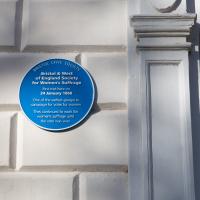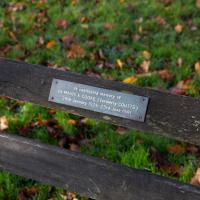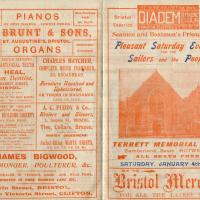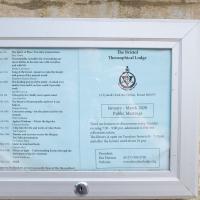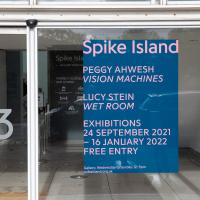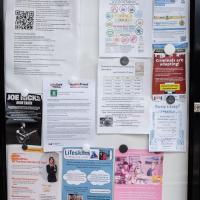Tagged: january
Clifton Village: Jesus and the Tympanum
12 Nov 2020
My goal is walk down every public road within a mile of me; sometimes it's not easy to tell what's public. I've passed the turning for Cornwallis Grove a thousand times, but never had a reason to venture down it, and although the street signs at the end seem to be council-deployed and I didn't spot any "private" signs, it's a gated road and definitely feels private.
Gathering all the white middle-class privilege I could muster, I wandered down and was rewarded with the sight of a Victorian pump, a statue of Jesus, and from the end of the road, a view of a private garden that once belonged to a private girls' school.
The Cornwallis House history page says:
In the early 20th century the house, together with Grove House, became a Catholic school, St Joseph’s High School for Girls.
The Congregation of La Retraite took over the school in 1924, with the nuns living in Grove House while the schoolrooms were
in Cornwallis House. The headmistress was Mother St Paul de la Croix (Sister Paula Yerby). By the 1970s La Retraite High
School had around 700 pupils.It closed in 1982 and the building was bought by Pearce Homes Ltd (now part of Crest Nicholson) who developed it into 21
flats. Grove House next door was bought by the Bristol Cancer Help Centre, and was later converted into flats in 2007.
Tags: Bristol Places UK onemilematt united kingdom Clifton Village
Auto-Tags: Azure Fixture Font Wall Material property Gas Electric blue Door Circle Room Signage Rectangle Facade Symmetry Molding
Text Recognition Tags: 5OCIETY BRISTOL Bristol & West CIVIC of England Society for Women's Suffrage First met here on 24 January 1868 One of the earliost groups to carmpaign for vokes for women They continued to work for woments suffrage until the vote was won 5OCIETY BRISTOL Bristol & West CIVIC of England Society for Women's Suffrage First met here on 24 January 1868 One of the earliost groups to carmpaign for vokes for women They continued to work for woments suffrage until the vote was won
Avoiding the Accounts
26 Nov 2020
I took the day off my day job to do my accounts—or at least do enough bookkeeping to send them to my accountant. I hate doing the books. I woke up late, tired and with a headache and decided to bunk off for a walk around Cliftonwood, Clifton Village and Clifton instead, taking in a couple of good coffees along the way. Thanks, Foliage Café, and Twelve for the flat whites.
I'd like someone to dedicate me a bench once I'm dead
Tags: Bristol Places UK onemilematt united kingdom
Auto-Tags: Wood Grass Plant Groundcover Font Bumper Natural material Rectangle Metal Soil Guard rail Landscape Sign Herb Outdoor bench
Text Recognition Tags: la continuing memory of De MAVIS E COOKE (formerly COUTTS) 24th January 1926-23rd Jene 19RI la continuing memory of De MAVIS E COOKE (formerly COUTTS) 24th January 1926-23rd Jene 19RI
Since setting up a search for Hotwells on eBay I've mostly managed to restrain myself from buying much (or in one case, was outbid, luckily for my finances.) However, I couldn't resist a 1902 flyer for a singalong at the Terrett Memorial Hall, which would have stood five minutes' walk from my flat, overlooking Howard's Lock.
I've found out a fair bit about this non-denominational seaman's mission, including tracking down both a Loxton drawing and an aerial photo of it. The main thing that's eluded me, ironically enough, is finding out who Terrett was, so as a Memorial Hall it didn't do a very good job 😀.
EDIT: Ah! Did a little more digging and found that the Bristol Archives has a Bristol Dock Company document on file called "William Terrett, Esq.; corresp. etc. re proposed erection of a Mission Hall at Cumberland Basin, 1892", so that might be worth a look once the Archives are properly open again. Given that:
Sarah Terrett died suddenly on 25 November 1889, aged 53, after speaking at a meeting of the White Ribbon Army, the temperance organization she had founded in 1878. Following her death many people sent letters of sympathy to her bereaved husband, William. One of these, from the Rev. W. F. James, a minister of the Bible Christians, makes for especially interesting reading. The Bible Christian denomination, to which Sarah and William belonged, was one of the smaller Methodist connexions, and had its heartland in rural Devon, the area where she had grown up. James recalled the hospitality he enjoyed when visiting the Terretts’ home, Church House, in Bedminster, south Bristol...
...I wonder if William Terrett built the hall in memory of his late wife. They were clearly just the kind of temperance movement people who would've founded a seaman's mission to get people together to have a nice non-alcoholic singsong rather than a night out on the tiles.
Anyway. This walk to grab a coffee from Hopper Coffee in Greville Smyth Park was mostly an excuse to post the leaflet, a few other things I found related to it, and some pictures of how the site looks now. I would suggest that the present day is not an improvement.
This was my random eBay purchase. I had no idea that the Terrett Memorial Hall had ever existed until I saw this leaflet up for sale.
There's some information on the hall on the Places of Worship database; as you can guess from the title of the leaflet it was basically a seaman's mission, with the aim "to promote the social, moral and religious welfare of sailors and provide sleeping accomodation for seamen, also free beds for destitute seafarers"
My favourite random thing on this leaflet is probably that the Surgeon Dentist is called Mr Heal.
Tags: Bristol Places UK onemilematt united kingdom Hotwells Cumberland Basin Flyover System Cumberland Piazza Cumberland Basin Terrett Memorial Hall
Auto-Tags: Font Material property Publication Brickwork Paper Book Pattern Paper product Brick History Newsprint Book cover Rectangle Holy places Document
Text Recognition Tags: BE SURE YOU CET THE ROYAL F RASNC DIADEM UR Hire Parebane PIANOS As to ATSS. Bristol of the per Month. BY BEST MAKERS LUWEST PRICS FRACTICAL TEST PRIVES THL BESTIneorponated Seamen and Boatmen's Friend Society. District W. BRUNT & SONS, ST. AUGUSTINE'S, BRISTOL. Pleasant Saturday Evenings Instreinenta Instrunents ORGANS Repatred. Exthanged roR THE Sailors and the People. ANERICAN A ENOISH DENTITRY Prize Medal ARTIFICIAL TEETH. Mr. HEAL, Surgeon Dentist, CHARLES HATCHER, COMPLETE HOUSE FURNISHER, 20, BROADMEAD. 25, OLD MAHKEr STREET. BRISTOL. Furnituro Repaired and Upholstered, the t quaty OR TAKEN IN EXCHANGE. CASIL OR IHIRK. a An Metais C Monik s pmaro WET oF NGLANO AND SOUTH WALES A. C. PUDDY & Co. PRRMANENT BUILDING SOCIETY Hosiers and Glovers, SL Staphan's ureat, Bristat he sosh ANNUAL REPORT 3. Dolphie St., BRISTOL Ties, Collars, Braces, Re Men t i anora frebeYBARS Ma FOR DORIDWER AY TER WINTER UNDERWEAR. Parfect-fitting WHITE SHIRTS, in a . e e TERRETT MEMORIAL HALL, Cumberland Basin. HOTWELLS A dm, A Ere JAMES BIGWOOD, ALL SEATS PREE. FISHMONGER, POULTERER, &c. SATURDAY, JANUARY 4th, 1902. BUY THE Bristol Mercury LICENSED DEALER IN VENISON, GAME AND WILD FOWL IMPORTER oF PURE WENHAM LAKE IOE. Baldwin Street, BRISTOS, and Victoria Street, CLIFTON. FOR ALL THE LATEST NEWS. BE SURE YOU CET THE ROYAL F RASNC DIADEM UR Hire Parebane PIANOS As to ATSS. Bristol of the per Month. BY BEST MAKERS LUWEST PRICS FRACTICAL TEST PRIVES THL BESTIneorponated Seamen and Boatmen's Friend Society. District W. BRUNT & SONS, ST. AUGUSTINE'S, BRISTOL. Pleasant Saturday Evenings Instreinenta Instrunents ORGANS Repatred. Exthanged roR THE Sailors and the People. ANERICAN A ENOISH DENTITRY Prize Medal ARTIFICIAL TEETH. Mr. HEAL, Surgeon Dentist, CHARLES HATCHER, COMPLETE HOUSE FURNISHER, 20, BROADMEAD. 25, OLD MAHKEr STREET. BRISTOL. Furnituro Repaired and Upholstered, the t quaty OR TAKEN IN EXCHANGE. CASIL OR IHIRK. a An Metais C Monik s pmaro WET oF NGLANO AND SOUTH WALES A. C. PUDDY & Co. PRRMANENT BUILDING SOCIETY Hosiers and Glovers, SL Staphan's ureat, Bristat he sosh ANNUAL REPORT 3. Dolphie St., BRISTOL Ties, Collars, Braces, Re Men t i anora frebeYBARS Ma FOR DORIDWER AY TER WINTER UNDERWEAR. Parfect-fitting WHITE SHIRTS, in a . e e TERRETT MEMORIAL HALL, Cumberland Basin. HOTWELLS A dm, A Ere JAMES BIGWOOD, ALL SEATS PREE. FISHMONGER, POULTERER, &c. SATURDAY, JANUARY 4th, 1902. BUY THE Bristol Mercury LICENSED DEALER IN VENISON, GAME AND WILD FOWL IMPORTER oF PURE WENHAM LAKE IOE. Baldwin Street, BRISTOS, and Victoria Street, CLIFTON. FOR ALL THE LATEST NEWS.
I managed to knock off a reasonable chunk of the roads I had left to walk around the University at the north-eastern extremity of my mile on this nice sunny walk. As well as being impressed by the number of big townhouses now occupied by various departments, I took some time on my way there to check out a war memorial, and some time on the way back to do a little extra wandering of Berkeley Square.
The Theosophical Society also lets its lodge be used by a variety of other organisations, including the Bristol Dowsers; a branch of Carlos Castaneda's Tensegrity folk (some of the videos of Tensegrity are quite something); a meditation group; and the local branch of the White Eagle Lodge, founded by a medium who received various teachings from the eponymous founder.
Given that those are the groups who openly practise there, I can only imagine the list of occult factions who use the rooms on other days...
Tags: Bristol Places UK onemilematt united kingdom Clifton Bristol Theosophical Lodge Theosophical Lodge theosophy
Auto-Tags: Rectangle Font Wood Commemorative plaque Landscape Symmetry History Memorial Public utility Circle Interior design
Text Recognition Tags: १८का Noy The Bristol Ihe Sprit at a Teabe ptia Theosophical Lodge ianer hatties becs vanale Sengtihe fesot-mt evkettee d prerd the rall Maten a Me mh Ihe bshng pewerthe id- det trdil d werk Taagrity orul adaat ind 14 Terudals Pukd. C. ri BS Y In kiry of lepale sad be January - March 2020 Public Meetings Mign e h Coesces catag -ke ptaette te Fe Ai d Wtheeg de l Acher Mad Adeiheld wel o Alke ley There are lectures or discuesionsaery Tday evening 70- 9:00 pm almisioe is te hit collectuns takem The libwary is open on Temdays Irom457m and after the lectune until about io pm. Mar un Te ed m thto Tee Tube tut Hes Oetinindan N enttigr t g kat he atda fne Prsident (OL17) 9047n5 www.beisthedodge ang Hei Hanon Webshe १८का Noy The Bristol Ihe Sprit at a Teabe ptia Theosophical Lodge ianer hatties becs vanale Sengtihe fesot-mt evkettee d prerd the rall Maten a Me mh Ihe bshng pewerthe id- det trdil d werk Taagrity orul adaat ind 14 Terudals Pukd. C. ri BS Y In kiry of lepale sad be January - March 2020 Public Meetings Mign e h Coesces catag -ke ptaette te Fe Ai d Wtheeg de l Acher Mad Adeiheld wel o Alke ley There are lectures or discuesionsaery Tday evening 70- 9:00 pm almisioe is te hit collectuns takem The libwary is open on Temdays Irom457m and after the lectune until about io pm. Mar un Te ed m thto Tee Tube tut Hes Oetinindan N enttigr t g kat he atda fne Prsident (OL17) 9047n5 www.beisthedodge ang Hei Hanon Webshe
I recently indulged myself by buying a little piece of history. I've mentioned Samuel Loxton and featured and linked to his drawings before, often in the eminently browsable Loxton Collection albums that Bristol Libraries has on Flickr. So when I saw a Loxton drawing of Hotwells pop up on eBay, I decided to get myself a little treat.
I don't think there's any Loxton drawing that features the road I actually live in—it's not very visible from anywhere else, not being one of these Clifton terraces that's perched at the top of a hill, or anything like that, and it's invisible in most views of the area. However, this Loxton drawing, Hotwells, Looking across the river from near the Clifton Bridge station, is probably the closest near-miss I've seen.
I decided to wander out one morning and see if I could reproduce the picture, and also take a photo or two of what's now become of the Clifton Bridge Station, which is still just about discernible in places.
(Then on an even stranger whim I decided to check out a possible little cut-through from Cumberland Road to the harbourside I'd been eyeing up on my commute to work, so walked to Wapping Wharf for a croissant via this potential new route, but that bit's not quite as interesting...)
Must pop in next weekend.
Tags: Bristol Places UK onemilematt united kingdom art Spike Island
Auto-Tags: Property Fixture Architecture Font Signage Facade Advertising Electric blue Glass Banner Metal Sign Event Graphics Logo
Text Recognition Tags: Spike Island Spike Isla +ALLERDTRAN PEGGY AHWESH VISION MACHINES HHONCT YOURSELA AND-OTHERS LUCY STEIN WET ROOM 133 EXHIBITIONS 24 SEPTEMBER 2021 -16 JANUARY 2022 FREE ENTRY Galery: Wednesday to Sunday, 12-5pm sokeisland.org.uk Spike Island Spike Isla +ALLERDTRAN PEGGY AHWESH VISION MACHINES HHONCT YOURSELA AND-OTHERS LUCY STEIN WET ROOM 133 EXHIBITIONS 24 SEPTEMBER 2021 -16 JANUARY 2022 FREE ENTRY Galery: Wednesday to Sunday, 12-5pm sokeisland.org.uk
Nipping Up the Zig Zag to the Shops
19 Aug 2023
It's been a long while since I did one of these walks.
I'm thinking of finishing up the project by walking one or two last bits of road, thus being able to declare with all honesty that I've done my best to walk every public road within my mile (and quite a few alleyways besides.) As a prelude, and just because I felt like it, I decided to drag out the camera and GPS on this little wander to the local shops.
Also looking nice and fresh since my last wander is the pair of community noticeboards, with a plethora of local news.
I found out recently that I was a winnner of one of the Hotwells & Cliftonwood Community Association 500 club prizes, which, alongside my membership, is a fun way to give money to the local organisation that puts up these noticeboards and does so much else for the community.
Tags: Bristol Places UK onemilematt united kingdom Clifton Village Hotwells Clifton
Auto-Tags: Poster Font Advertising Picture frame Signage Display board Event Wood Facade Publication Transport Landscape Banner Art
Text Recognition Tags: Howells and Cliftonwood Community Association (ACCA) community cond Useful local information Cond Local Pang Vefa Avon and R Ay GTA abyQMalaw De Oy He PO De 30 G F PAD Lesson for t FRA Obag w BATANGA to your whatapang Var JOE MICKS GUITAR TEACHER BUTHORE.COM y Gramgenee07504 ty PO Box 200 Online Coaching and 61100 TW utrition Quidance Fra ersonal Training sessions LONDRE om prope tech y and get aang d 222000 Get Fit, Be Healthier, Be The Best Version Of You! www.top be and reach SOF ing out to Our sto Quran We have ww Facebook Tutir @COtt G35 Top for my on or stop you A O 07564375433 @w tabourside and Satu Action Fraud ALERT AF Google .***. of St DAS y Th y AudionFraud SA 13304 W 15. Ch Lifeskitts LEARNING FOR LIVING Guing which includes working wilt amal and active safatyti Wysan bes the fe WELCOME SPACE at CLIFTON LIBRARY activitating January 2635 (10 ng WELCOME SPACE We are currently looking for people to help us deliver safety education to children via our enginteractive village based in central Bristol www50 Hotwells & Cliftonwood Community Association 500 CLUB RESULTS 2023 1 mn m Hot drinks Relax GAMES CRAFTING Films CHAT Wellbeing Newspapers Study KAPHY TABLE TENNIS Hasting which includes opening and sing talk with the c sporting teachers re The 100 Challe Join us for a tester heut Wednesday 12th April is the next scheduled taster hour please contact the email below for more information and to book your place OLLYW4 Hvat e ang pag Apt Now swight Robert C con Nowhe CIP ad NC Nowe Man No for 2 yr y dece ww OXO AUTY New THANK YOU TO ALL OF THE YOUR 300C SUCTIONS A HANG POSLE POES THAT HELPO THE LOCALE EVERY MONTH WE HAVE UNCLAIMED PRIZE HONEY THAT COULD YOUR CLUB FOR THE CHANCE TO BE YOU NAM NAD OF NO WINNER OWN AND SUPPORT THE WORK OF YOUR LOCAL COMMUNITY SCAN ME bile PR COURE Ap C Te qu 700 Emetas T Com You to t You fost d Shpaloaph we would love to make oef regularly vegade ba ne Beinart Art & Art haling p A you missing making an DEMENTIA SAFEGUARDING SCHEMEL www.beinartotive.c 4 Ben sad fin BEWARE PROSITY Criminals are adapting! there are many where you ca weket M -Tudo que fa thoshwade - pada poleg oniks and li MA ART whick - server creaty PCRIME and the deving the vers If you're not sure, research more! www Having a baby? - PRACTICAL and EMOTIONAL support is available for you in the cala in pomancy, birth and pomnically Sear Roma Helen Whit ANME PROCITY O Howells and Cliftonwood Community Association ( ACCA ) community cond Useful local information Cond Local Pang Vefa Avon and R Ay GTA abyQMalaw De Oy He PO De 30 G F PAD Lesson for t FRA Obag w BATANGA to your whatapang Var JOE MICKS GUITAR TEACHER BUTHORE.COM y Gramgenee07504 ty PO Box 200 Online Coaching and 61100 TW utrition Quidance Fra ersonal Training sessions LONDRE om prope tech y and get aang d 222000 Get Fit , Be Healthier , Be The Best Version Of You ! www.top be and reach SOF ing out to Our sto Quran We have ww Facebook Tutir @COtt G35 Top for my on or stop you A O 07564375433 @w tabourside and Satu Action Fraud ALERT AF Google . *** . of St DAS y Th y AudionFraud SA 13304 W 15. Ch Lifeskitts LEARNING FOR LIVING Guing which includes working wilt amal and active safatyti Wysan bes the fe WELCOME SPACE at CLIFTON LIBRARY activitating January 2635 ( 10 ng WELCOME SPACE We are currently looking for people to help us deliver safety education to children via our enginteractive village based in central Bristol www50 Hotwells & Cliftonwood Community Association 500 CLUB RESULTS 2023 1 mn m Hot drinks Relax GAMES CRAFTING Films CHAT Wellbeing Newspapers Study KAPHY TABLE TENNIS Hasting which includes opening and sing talk with the c sporting teachers re The 100 Challe Join us for a tester heut Wednesday 12th April is the next scheduled taster hour please contact the email below for more information and to book your place OLLYW4 Hvat e ang pag Apt Now swight Robert C con Nowhe CIP ad NC Nowe Man No for 2 yr y dece ww OXO AUTY New THANK YOU TO ALL OF THE YOUR 300C SUCTIONS A HANG POSLE POES THAT HELPO THE LOCALE EVERY MONTH WE HAVE UNCLAIMED PRIZE HONEY THAT COULD YOUR CLUB FOR THE CHANCE TO BE YOU NAM NAD OF NO WINNER OWN AND SUPPORT THE WORK OF YOUR LOCAL COMMUNITY SCAN ME bile PR COURE Ap C Te qu 700 Emetas T Com You to t You fost d Shpaloaph we would love to make oef regularly vegade ba ne Beinart Art & Art haling p A you missing making an DEMENTIA SAFEGUARDING SCHEMEL www.beinartotive.c 4 Ben sad fin BEWARE PROSITY Criminals are adapting ! there are many where you ca weket M -Tudo que fa thoshwade - pada poleg oniks and li MA ART whick - server creaty PCRIME and the deving the vers If you're not sure , research more ! www Having a baby ? - PRACTICAL and EMOTIONAL support is available for you in the cala in pomancy , birth and pomnically Sear Roma Helen Whit ANME PROCITY O
